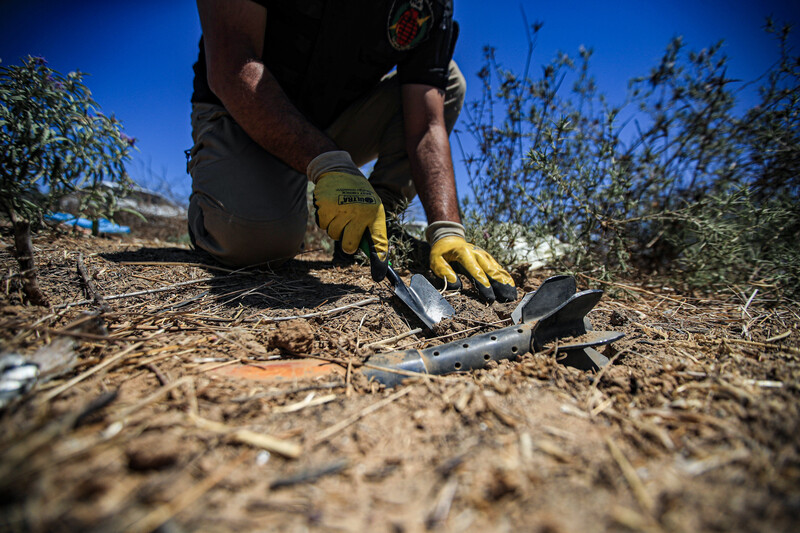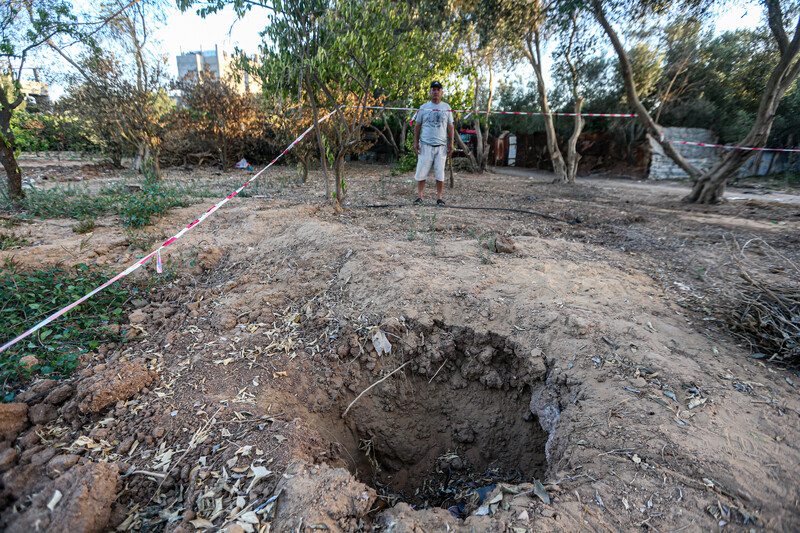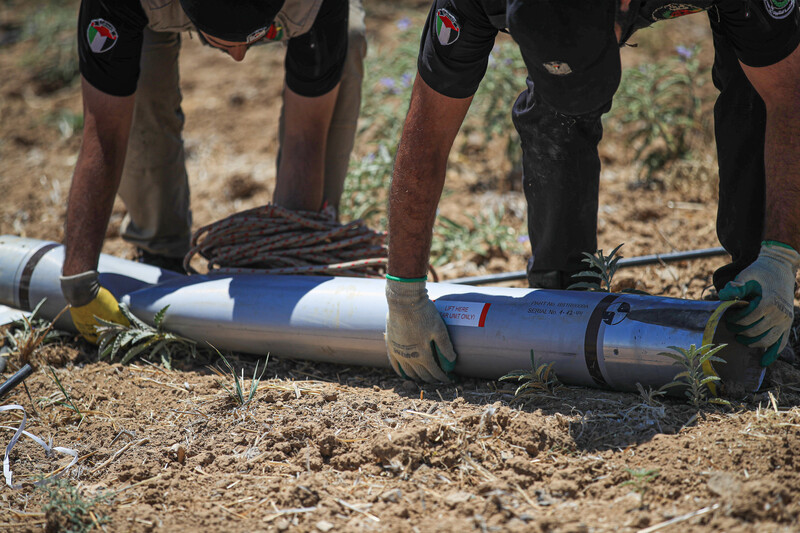The Electronic Intifada 21 August 2023

A member of Gaza’s General Department of Forensic Evidence and Explosive Ordnance Disposal team uses a shovel to remove an ordnance component in eastern Gaza on 18 July 2023.
The Electronic IntifadaHijazi Abu Jarad’s home in Beit Hanoun in northern Gaza is surrounded by olive and citrus trees. The orchard is normally a pleasant place to be, but it is currently cordoned off by red and white caution tape.
Near the center of that tape is a hole, about one meter wide and eight meters deep, and inside the hole is an unexploded Israeli bomb.
The soil is soft on Abu Jarad’s farm, so this bomb did not detonate on impact. Instead, it sank into the earth the night of 12 May 2023, during Israel’s five-day attack on Gaza.
“The bomb may explode at any time,” Abu Jarad said. “Five families live in the area. My neighbor often doesn’t sleep in his house out of fear.”
The bomb is located about 30 meters from Abu Jarad’s home, where he lives with 11 family members, including eight grandchildren.
“Even going to the grocery is a perilous task,” Abu Jarad said. “When I go out, the rocket and my grandchildren are still in my mind.”

Farmer Hijazi Abu Jarad stands next to a hole that contains a deep-buried bomb dropped by Israel during the May 2023 attack near his home in Beit Hanoun, Gaza.
The Electronic IntifadaCrews from the United Nations Mine Action Service (UNMAS) and Gaza’s General Department of Forensic Evidence and Explosive Ordnance Disposal, or EOD, have visited the site and confirmed that the bomb has not exploded.
Still, the Gaza-based teams have not been able to remove the bomb because it is so deeply buried; they must wait for the equipment and funding of UNMAS.
The bomb has hindered all operations on Abu Jarad’s farm, the family’s main source of income, since he can’t access parts of his land.
Abu Jarad’s dilemma is not an anomaly in Gaza, where 19 Palestinians were killed and 170 injured by explosive remnants of war from 2014 to 2020.
According to the UN, 8,786 explosive remnants of war have been removed and destroyed since 2014; 7,000 of those remnants were from Israel’s 2014 war.
Major Ahmad Othman, the director of the technical unit of Gaza’s EOD department, told The Electronic Intifada that the EOD team has carried out more than 300 field missions since May. On 32 occasions, those missions concerned Iron Dome missile remnants. By his unit’s estimate, Israel dropped 277 tons of ordnance on Gaza during its May attacks.
Without access to the latest ordnance removal equipment or advanced training abroad due to the Israeli siege, Gaza’s EOD teams often find themselves ill-equipped to dispose of Israeli ordnance. Othman said that 17 EOD team members have been killed while removing ordnance in the last two decades.
Othman himself lost several fingers while disposing of unexploded ordnance in 2018.
“The EOD is completely civilian and we need the equipment to rescue people,” he said.
The EOD has appealed to international bodies to pressure Israel into allowing the much-needed equipment.
Deep-buried bombs
The Electronic Intifada joined Othman’s EOD team on a mission in the eastern Gaza neighborhood of Zeitoun in July.
After almost three hours of combing the area under the scorching sun, the four-member crew found an Iron Dome missile that had been launched in May 2023.

Members of Gaza’s General Department of Forensic Evidence and Explosive Ordnance Disposal team transport an unexploded Iron Dome missile in eastern Gaza, on 18 July 2023.
The Electronic IntifadaThe crew used ropes to move the explosive remnants.
“We don’t have any bomb suits due to the siege,” Othman said. “We use ropes to move the explosive remnants, although this is a very primitive way, because we don’t have robots or modern equipment.”
The crews have only a single four-wheel cart to facilitate ordnance transportation. And due to the lack of bulldozers, they use shovels and other basic tools for excavation.
Once removed, the ordnance is then loaded onto the beds of their trucks, which are not shrapnel-proof.
Othman noted that the lack of equipment puts crews’ lives at risk.
And yet another challenge faced by the crews is that they are not able to extract deep-buried ordnance.
“We don’t have equipment,” Othman said. “We can’t pull out deep-buried bombs. We have to wait for UNMAS to work on fully funded projects.”
While the EOD teams and UNMAS have disposed of dozens of deep-buried bombs in recent years, Othman said there are still at least seven deep-buried bombs in Gaza.
To dispose of the unexploded ordnance, the crews use explosive material to detonate it off-site.
“We still have dozens of unexploded Israeli white phosphorus [bombs] since 2008 and we still don’t know how to dispose of them,” he said. “The needed explosive material is missing in Gaza and Israel has refused to [let it enter].”
Wrecked resort
Ayman Shamlakh, the owner of Al-Baidar Resort on the coast of Gaza City, is still waiting for an EOD team to remove unexploded ordnance from his property.
In February 2023, Israel targeted the resort with a barrage of rockets, reducing it to ruins.
“Israel claimed the place was used for military purposes,” said Shamlakh, who noted that there is no truth to this claim. He ran the resort for 25 years, and it was his primary source of income, earning around $50,000 a year.
Yet now there is a bomb buried deep in the ground and he cannot begin reconstruction on his resort or remove any rubble until the ordnance is excavated.

Ayman Shamlakh’s Al-Baidar Resort in Gaza has been targeted by Israel numerous times.
The Electronic IntifadaThis was not the first time Israel attacked his resort, which is located near a Palestinian military outpost. The resort was also damaged during Israeli attacks in 2012, 2014 and 2021.
“Each damage would cost me from $10,000 to $20,000,” he said. “The place cost me one million dollars [to build].”
Salah Abdul Ati, the director of the International Commission to Support Palestinians’ Rights, said that Israel’s use of white phosphorus bombs, vacuum bombs and suicide drones puts Palestinians at exceptional risk.
As the top supplier of military aid to Israel – $3.8 billion annually – the United States is equally culpable.
Referring to Israel’s unlawful employment of white phosphorus and other attacks, Abdul Ati stated, “Israel intentionally uses internationally banned weapons in densely populated areas in Gaza.” He added, “Israel has used the Palestinian territories, especially Gaza, as a testing ground for its weapons.”
Environmental decay
Muhammad Musleh, director of the environmental protection unit at Gaza’s Water Environmental Quality Authority, told The Electronic Intifada that the Israeli ordnance dropped on Gaza is an exceptionally perilous and noxious threat to the environment. Musleh, who participated in a study examining the destructive impact of Israel’s 2014 war on Gaza’s environment, noted that the bombings have contaminated crops and destroyed soil quality in agricultural areas.
“Rainfall causes the toxic components to seep into the groundwater,” Musleh said, noting that deep-buried bombs “pose a significant threat to the people and the environment.”
Back in Beit Hanoun, on Abu Jarad’s farm, the May 2023 bombing destroyed 50 olive trees and numerous seedlings, contaminating the soil with toxic components and harming the productivity of the farm.
“Trees can’t grow where the rockets bombed,” farmer Abu Jarad said. “When I run the tap water [which is from a well], I clearly see the gray and black polluted water.”
Ahmed Al-Sammak is a journalist based in Gaza.




